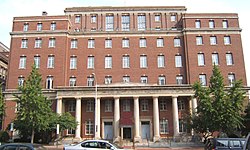Wills Eye Hospital
| Wills Eye Hospital | |
|---|---|
 | |
 Wills Eye Hospital outpatient entrance | |
 | |
| Geography | |
| Location | 840 Walnut Street, Philadelphia, Pennsylvania, United States |
| Organization | |
| Type | Specialist |
| Affiliated university | Thomas Jefferson University |
| Services | |
| Speciality | Ophthalmology |
| History | |
| Opened | 1832 |
| Links | |
| Website | http://www.willseye.org |
| Lists | Hospitals in Pennsylvania |
Wills Eye Hospital is a non-profit eye clinic and hospital in Philadelphia, Pennsylvania. It was established in 1832 and is the oldest continually operating eye-care facility in the United States. It is the ophthalmology residency program for Thomas Jefferson University.
Since 1990, Wills Eye Hospital has consistently been ranked one of the top three ophthalmology hospitals in the United States by U.S. News & World Report and its ophthalmology residency program is considered one of the most competitive residency programs in the world.[1]
History
[edit]
James Wills Jr., a Quaker merchant, was instrumental in the founding of Wills Eye through his bequest of $116,000 in 1832 to the City of Philadelphia. Wills stipulated that the funds were to be used specifically for the indigent, blind, and lame. Over the years it evolved into solely an eye hospital. The first Wills Hospital opened in 1834 on Logan Square at 18th & Race Streets.
Early surgeons at Wills Eye included Isaac Parrish, M.D. and Isaac Hays, MD,[2] George Fox, M.D., and Squier Littell, M.D., who in 1837 wrote "A Manual of Diseases of the Eye."[3] In 1854, Littell also co-edited "A Treatise on Operative Ophthalmic Surgery" with Henry Haynes Walton.[4]
Historic building
[edit]Wills Eye Hospital | |
 Wills Hospital location from 1932-1980 (building located at 1601 Spring Garden Street Philadelphia, Pennsylvania) | |
| Coordinates | 39°57′48″N 75°9′56″W / 39.96333°N 75.16556°W |
|---|---|
| Area | 0.8 acres (0.32 ha) |
| Built | 1931-1932 |
| Architect | John T. Windrim |
| Architectural style | Federal Tuscan |
| NRHP reference No. | 84003582[5] |
| Significant dates | |
| Added to NRHP | July 12, 1984 |
| Designated PHMC | October 9, 2009[6] |
The Centennial Building of Wills Eye Hospital was designed by architect John T. Windrim and built in 1931-1932. It is a six-story, brick building measuring 154 by 157 feet (47 by 48 m). The front facade features a portico with eight Tuscan order columns.[7] The building is now residential apartments.
It was added to the National Register of Historic Places in 1984.[5]
Medical achievements
[edit]Wills Eye has pioneered many techniques in the field of ophthalmology, including:
- Artificial intraocular lens implant (1952), Warren Reese, MD and Turgut Hamdi, MD
- Invention of a vitrectomy machine (1972), Jay Federman, MD
- Artificial retinal implant (2009), Julia Haller, MD, Allen Ho, MD and Carl Regillo, MD [8][9]
Notable people
[edit]- Charles D. Kelman, MD (Wills Eye residency 1956–1960) - father of phacoemulsification and inventor of the cryoprobe[10]
- Jerry A. Shields
- Carol Shields
- George Spaeth
- William Tasman
- Santosh G. Honavar
Senior officials
[edit]- Joseph Bilson, Executive Director, Wills Eye (2007–present)
- Julia A. Haller, MD, Ophthalmologist-in-Chief, Wills Eye (2007–present)
References
[edit]- ^ "Rankings". health.usnews.com. Retrieved 2019-05-27.
- ^ Jackson, Samuel. Memoir of Isaac Parrish, M.D.[1], Google Books.
- ^ "Bernard Becker Collection in Ophthalmology - Records #201-250". beckerexhibits.wustl.edu.
- ^ Walton, Henry Haynes and Littell, Squier, "A Treatise on Operative Ophthalmic Surgery",[2] Google Books.
- ^ a b "National Register Information System". National Register of Historic Places. National Park Service. July 9, 2010.
- ^ "PHMC Historical Markers". Historical Marker Database. Pennsylvania Historical & Museum Commission. Retrieved December 10, 2013.
- ^ "National Historic Landmarks & National Register of Historic Places in Pennsylvania" (Searchable database). CRGIS: Cultural Resources Geographic Information System. Note: This includes George E. Thomas (February 1984). "National Register of Historic Places Nomination Form: Wills Hospital" (PDF). Retrieved 2012-06-16.
- ^ Gorman, Ali, Artificial retina gives hope for sight. ABCgolocal.com.
- ^ Avril, Tom Implant gives new hope to the blind. philly.com, Sept. 8, 2009.
- ^ Through My Eyes: The Charlie Kelman Story, January 2010, WLIW21, New York
Sources
[edit]- Tasman, William. The History of Wills Eye Hospital Lippincott, 2nd edition (1987). ISBN 0-397-50918-9 OCLC 16228147
External links
[edit]![]() Media related to Wills Eye Hospital at Wikimedia Commons
Media related to Wills Eye Hospital at Wikimedia Commons





